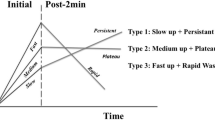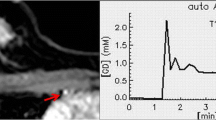Abstract
There is interest in applying novel methods to dynamic MR mammography (MRM). One such possibility is to administer an exogenous hyperoxic contrast agent, such as carbogen (95–98% O2 and 2–5% CO2) or pure oxygen (100% O2). We report our first experiences with these agents in a patient with an invasive lobular carcinoma. Fourteen dynamic series were acquired with an rf-spoiled 2D multislice gradient echo sequence, including three measurements while breathing air, four measurements with 100% oxygen, three measurements with air and four measurements with carbogen. Afterwards, 0.1 mmol/kg bw of Gd-DTPA was administered to obtain dynamic T1-weighted double-echo 3D axial gradient echo images (TR/TE1/TE2/α=7.8 ms/2 ms/4.76 ms/15°) every 90 s up to 4.5 min after injection. The lesion was well delineated on the contrast-enhanced images, contrary to magnitude images reconstructed from the raw data sets acquired during air/oxygen/carbogen breathing. A ROI-based median-filtered signal-time course revealed a tumor signal increase of roughly 15% between scans acquired during air and oxygen breathing. Though preliminary, these first results are encouraging concerning the exploration of these alternative contrast agents in MRM in greater detail.



Similar content being viewed by others
References
Kaiser WA, Zeitler E (1989) MR-imaging of the breast: fast imaging sequences with and without Gd-DTPA. Radiology 170:681–686
Heywang-Köbrunner SH, Viehweg P, Heinig A, Kuchler C (1997) Contrast-enhanced MRI of the breast: accuracy, value, controversies, solutions. Eur J Radiol 24:94–108
Van Goethem M, Schelfout K, Dijckmans L, Van der Auwera JC, Weyler J, Verslegers I, Biltjes I, De Schepper A (2004) MR mammography in the preoperative staging of breast cancer in patients with dense breast tissue: comparison with mammography and ultrasound. Eur Radiol 14:809–816
Choi BG, Kim HH, Kim EN, Kim BS, Han JY, Yoo SS, Park SH (2002) New subtraction algorithms for evaluation of lesions on dynamic contrast-enhanced MR mammography. Eur Radiol 12:3018–3022
Wedegartner U, Bick U, Wortler K, Rummeny E, Bongartz G (2001) Differentiation between benign and malignant findings on MR-mammography: usefulness of morphological criteria. Eur Radiol 11:1645–1650
Van Goethem M, Schelfout K, Kersschot E, Colpaert C, Verslegers I, Biltjes I, Tjalma WA, Weyler J, De Schepper A (2004) Enhancing area surrounding breast carcinoma on MR mammography: comparison with pathological examination. Eur Radiol 14:1363-1370
Baum F, Fischer U, Vosshenrich R, Grabbe E (2002) Classification of hypervascularized lesions in CE MR imaging of the breast. Eur Radiol 12:1087–1092
Mahfouz AE, Sherif H, Saad A, Taupitz M, Filimonow S, Kivelitz D, Hamm B (2001) Gadolinium-enhanced MR angiography of the breast: is the breast cancer associated with ipsilateral higher vascularity? Eur Radiol 11:965–969
Fischer DR, Baltzer P, Malich A, Wurdinger S, Freesmeyer MG, Marx C, Kaiser WA (2004) Is the “blooming sign” a promising additional tool to determine malignancy in MR mammography? Eur Radiol 14:394–401
Daldrup-Link HE, Brasch RC (2003) Macromolecular contrast agents for MR mammography: current status. Eur Radiol 13:354–365
Robinson SP, Rijken PF, Howe FA, McSheehy PM, Van Der Sanden BP, Heerschap A, Stubbs M, Van der Kogel AJ, Griffiths JR (2003) Tumor vascular architecture and function evaluated by non-invasive susceptibility MRI methods and immunohistochemistry. J Magn Reson Imaging 17:445–454
Rijpkema M, Kaanders JH, Joosten FB, van der Kogel AJ, Heerschap A (2002) Effects of breathing a hyperoxic hypercapnic gas mixture on blood oxygenation and vascularity of head- and-neck tumors: measured by magnetic resonance imaging. Int J Radiat Oncol Biol Phys 53:1185–1191
Taylor NJ, Baddeley H, Goodchild KA, Powell ME, Thoumine M, Culver LA, Stirling JJ, Saunders MI, Hoskin PJ, Phillips H, Padhani AR, Griffiths JR (2001) BOLD MRI of human tumor oxygenation during carbogen breathing. J Magn Reson Imaging 14:156–163
Karczmar GS, River JN, Li J, Vijayakumar S, Goldman Z, Lewis MZ (1994) Effects of hyperoxia on T2* and resonance frequency weighted magnetic resonance images of rodent tumors. NMR Biomed 7:3–11
Kuperman VYu, River JN, Lewis MZ, Lubich LM, Karczmar GS (1995) Changes in T2*-weighted images during hyperoxia differentiate tumors from normal tissue. Magn Reson Med 33:318–325
Peller M, Weissfloch L, Stehling MK, Weber J, Bruening R, Senekow-Schmidtke R, Molls M, Reiser M (1998) Oxygen-induced MR signal changes in murine tumors. Magn Reson Imaging 16:799–809
Robinson PS, Rodrigues LM, Howe FA, Stubbs M, Griffiths JR (2001) Effects of different levels of hypercapnic hyperoxia on tumour R2* and arterial blood gas. Magn Reson Imaging 19:161–166
Al-Hallaq HA, River JN, Zamora M, Oikawa H, Karczmar GS (1998) Correlation of magnetic resonance and oxygen microelectrode measurements of carbogen-induced changes in tumor oxygenation. Int J Radiat Oncol Biol Phys 41:151–159
Robinson SP, Howe FA, Griffiths JR (1995) Noninvasive monitoring of carbogen-induced changes in tumor blood flow and oxygenation by functional magnetic resonance imaging. Int J Radiat Oncol Biol Phys 33:855–859
Author information
Authors and Affiliations
Corresponding author
Rights and permissions
About this article
Cite this article
Fischer, D.R., Reichenbach, J.R., Rauscher, A. et al. Application of an exogenous hyperoxic contrast agent in MR mammography: initial results. Eur Radiol 15, 829–832 (2005). https://doi.org/10.1007/s00330-004-2484-0
Received:
Revised:
Accepted:
Published:
Issue Date:
DOI: https://doi.org/10.1007/s00330-004-2484-0




